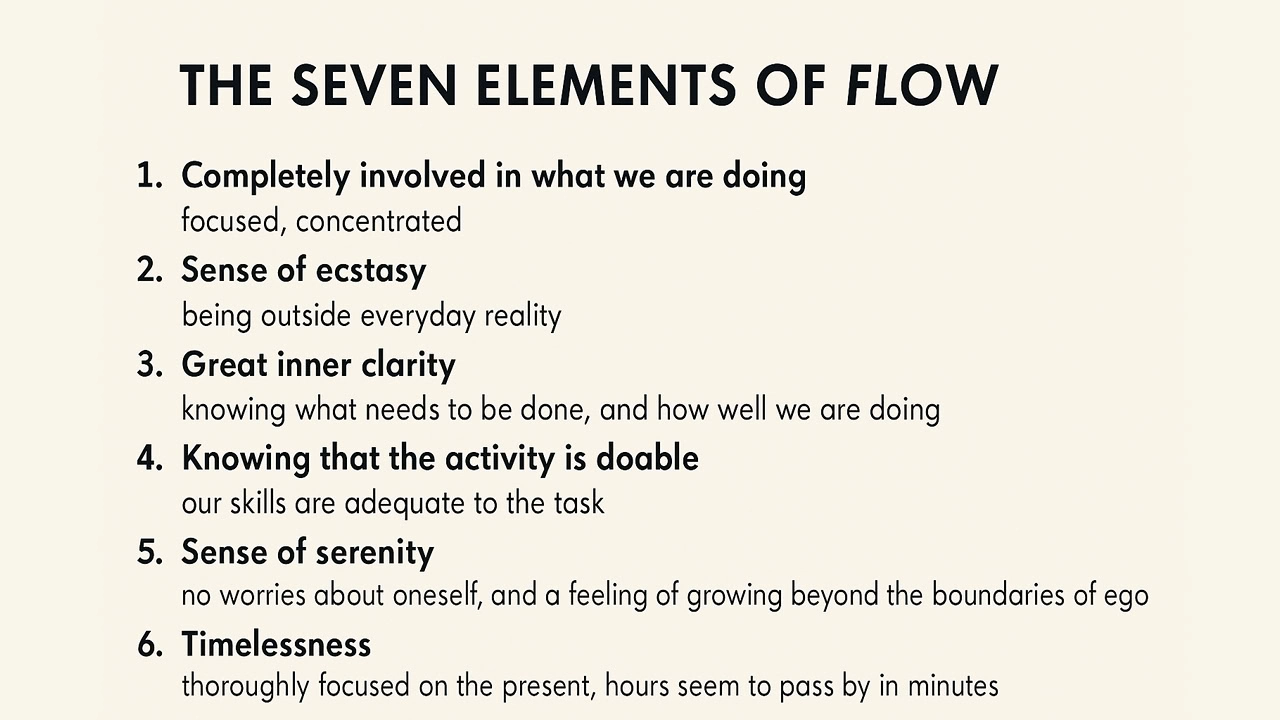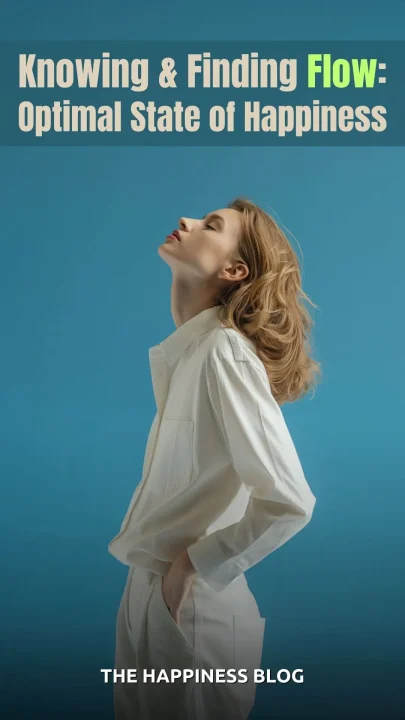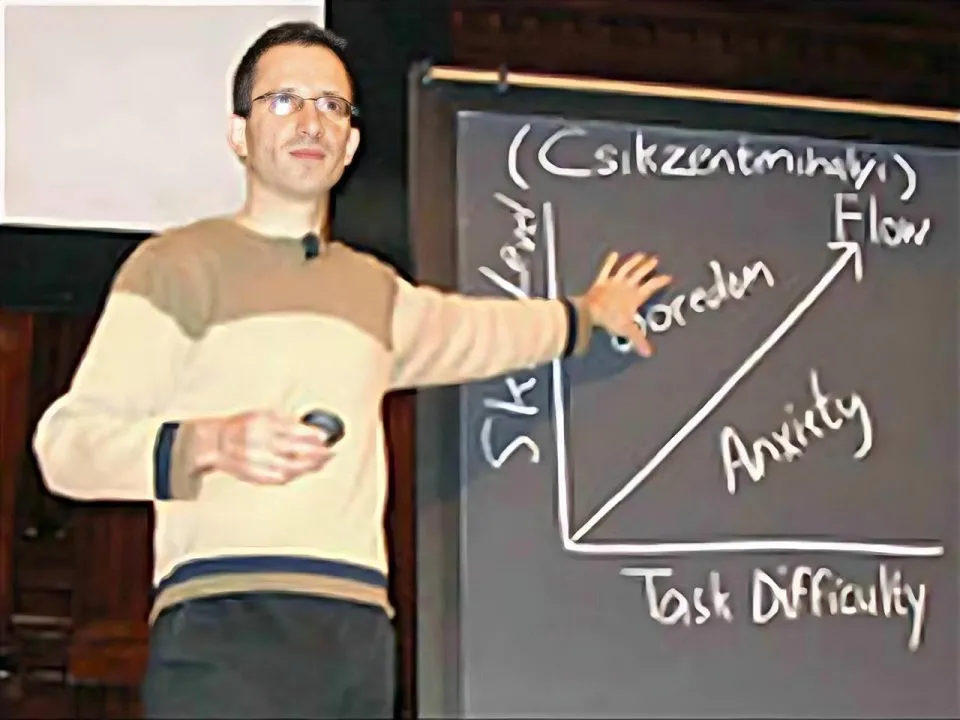Today's Friday • 10 mins read
— By Dr. Sandip Roy.
“In many ways, the secret to happiness is to learn to get flow from almost everything we do,
including work and family.” — M. Csikszentmihalyi
Ever been so absorbed in a task that you forgot the world outside? Hours passed, and you didn’t notice. Maybe you started reading a book in a morning, and when you looked up, it was late afternoon.
You just kept reading, immersed in the events, without any even a hint of boredom or fatigue.
That was “flow.” In flow, we can perform at our peak and produce our best work, all from a zone of effortless bliss.
Scientists, musicians, artists, athletes, and painters know how to slip into the flow state at will. They enter and stay in this zone for hours, without feeling sleepy or hungry.
What Is “Flow”
Researcher Mihaly Csikszentmihalyi (pronounced me-high chick-sent-me-high) brought the world’s attention to Flow, explaining it as a “holistic sensation” we get when we’re fully involved in our actions.
Flow is a state of intense focus and effortless performance that is rooted in mindfulness. It lets us perform at our peak level of creativity, productivity, and fulfillment without being distracted, bored, or tired. The brain in “flow” is in an optimal state of happiness.
7 Key Components of Flow:
- Complete involvement: Total focus and concentration on the task at hand.
- Sense of ecstasy: Feeling detached from everyday reality.
- Great inner clarity: Knowing what needs to be done and how well it’s being done.
- Activity is doable: Confidence that one’s skills are adequate for the task.
- Sense of serenity: Freedom from self-doubt and a feeling of transcending the ego.
- Timelessness: Deep focus on the present, where time seems to pass quickly.
- Intrinsic motivation: The activity itself becomes its own reward.

According to EEG studies, the flow state is characterized by increased theta and alpha waves in the frontal areas and moderate alpha waves in the frontal and central areas of the brain (Katahira & Yamazaki, 2018).
Flow: A state in which people are so involved in an activity that nothing else seems to matter; the experience is so enjoyable that people will continue to do it even at great cost, for the sheer sake of doing it.
— Mihaly Csikszentmihalyi, Father of “Flow”
When Wired magazine asked Csikszentmihalyi what he meant by flow, he replied:
(Flow is) being completely involved in an activity for its own sake. The ego falls away. Time flies. Every action, movement, and thought follows inevitably from the previous one, like playing jazz. Your whole being is involved, and you’re using your skills to the utmost.
7 Elements of Flow
Mihaly Csikszentmihalyi identified seven key elements that contribute to flow state:
- Balance Challenge and Skill: The activity should be challenging, but not too difficult to frustrate you.
- Clear Goals: Well-defined goals for the task helps you focus your attention and maintain motivation.
- Immediate Feedback: Quick feedback on your task lets you adjust your approach and stay engaged.
- Deep Focus: Minimizing distractions to fully immerse yourself in the activity is a prerequisite for flow.
- Loss of Self-Consciousness: In flow, you tend to lose awareness of yourself and your surroundings.
- Time Distortion: Time seems to pass more quickly or slowly when you’re in flow.
- Sense of Control: You feel in total control of the activity and its outcome.
Why We Need Flow: Benefits of Flow
Flow offers us a peak positive experience that is its own reward. Beyond that, flow has several proven benefits:
- Increase motivation. Those who achieve the flow state in an activity feel more motivated to engage in that activity (Jackson et al., 1998).
- Enhance performance. Those in a flow state continue to perform at higher levels since they keep finding innovative solutions to tackle the problems within a task (Jackson et al., 2001; MacDonald et al., 2006).
- Avoid anxiety and boredom. Anxiety occurs when the task difficulty is high, but the skill level is low. Boredom occurs when the skill level is high, but the task difficulty is low. Flow experiences help high achievers avoid both anxiety and boredom. Flow occurs when skill and challenge levels are both above average and balanced against each other (Nakamura, 1988).
- Optimal productivity. Flow integrates creative insights and quick decisions to result in optimal productivity with the least effort. So, flow may offer the highest ROI (return on investment) for your efforts.
So, how can you enter the flow state at will? Read on.

How To Find Flow: The Authentic State of Happiness
- Flow generally occurs while doing your favorite activity – gardening, listening to music, or cooking.
- You may also enter flow when you’re driving, talking to friends, and surprisingly, often at your work.
- Rarely, some people report flow in passive leisure activities, such as watching television or relaxing.
But those are instances of getting into flow unintentionally. Can you enter the flow state intentionally?
Here are some ways to intentionally induce flow state:
- Choose Activities You Enjoy: Select activities that genuinely interest you and are in line with your passions.
- Set Clear Goals: Break down larger tasks into smaller ones to optimize goal attainability, maintain focus., and boost grit.
- Create a Conducive Environment: Minimize distractions by finding a quiet space where you can concentrate.
- Practice Mindfulness: Engage in mindfulness techniques like meditation to enhance focus and awareness.
- Experiment with Different Activities: Don’t be afraid to try new things to discover activities that trigger flow.
- Embrace Challenges: Set up some stretch-goals to push your limits and learn new skills.
- Be Patient: Flow state may not occur immediately. Practice and persistence are key.
Flow Theory In Positive Psychology
Flow is an optimal experience, defined as a sense of intrinsic reward felt during immersive engagement in a task that inspires intense commitment.
Research by Csikszentmihalyi showed a flow state needs at least two key things to exist together: goals and feedback.
- Goal: When people take on challenges that they believe are just at the right level for their expertise, they enter a flow state. The challenge should not be too difficult so that people become frustrated, nor too easy so that they become bored. People tend to quit the task if either of these conditions happens.
- Feedback: It is critical that those who take on the challenge have clear short-term goals and receive immediate feedback on their success. This keeps people informed of their progress, as well as their successes and failures, and allows them to adjust their actions in line with their goals.
A flow state results from actively focusing on a task. However, the task must be challenging, have clear goals, and provide immediate feedback.
Nakamura and Csikszentmihalyi, 2002 show the following nine universal factors of flow are:
- Clear goals
- A sense of control
- Autotelic experience
- Challenge-skill balance
- Transformation of time
- Unambiguous feedback
- Loss of self-consciousness
- Action-awareness merging
- Concentration on the task at hand
All of us can get into the flow state by learning the way to concentrate and hold our attention. Once in a flow state, you will lose your consciousness of the surroundings, while becoming one with the activity in your hand.
The flow is a state of immersion into a self-contained universe, whenever we get involved in an activity of profound interest.
Flow = Autotelic Experience
Flow is an autotelic experience (Nakamura and Csikszentmihalyi, 2009).
An autotelic experience refers to an activity that is inherently pleasant, enjoyable, and motivating.
An autotelic person is one who generally does a thing for its own sake, in the “here and now”, rather than for some long-term goals.
Mihaly Csikszentmihalyi describes people who are autotelic as: “…those who need few material possessions and little entertainment, comfort, power, or fame because so much of what he or she does is already rewarding.”
History of Flow
Flow always existed. No one invented it.
This state of complete immersion into the task at hand finds mention many times in history and culture. Examples are Michelangelo and the Sistine Chapel, Orpheus and his golden lyre, and Arjuna and the eye of the fish.
The world has long known that painters, sculptors, musicians, and other artists can become so engrossed in their craft that they forget to eat, drink, or even sleep.
In 1975, the Hungarian-American psychology professor Mihaly Csikszentmihalyi researched and brought the concept of flow into the public limelight.

Why Is Flow The Optimal State Of Happiness?
“Enjoyment appears at the boundary between boredom and anxiety, … when a person’s body or mind is stretched to its limits in a voluntary effort to accomplish something difficult and worthwhile.” — Csikszentmihalyi
Flow is the optimal state of happiness because of these reasons:
1. Deep Focus and Mindfulness
- Reduced Mental Clutter: Flow state lets us focus intensely on a single task, reducing the mental clutter caused by multitasking and constant distractions.
- Enhanced Mindfulness: By being fully present in the present moment, we get a heightened sense of awareness and appreciation for the task at hand.
2. Intrinsic Motivation and Satisfaction
- Pursuit of Excellence: Flow activities often involve challenges that push us to our limits, leading to a sense of accomplishment and personal growth.
- Intrinsic Rewards: The joy and satisfaction derived from the flow experience itself are often more powerful than external rewards like money or praise.
3. Time Distortion and Enhanced Well-being
- Altered Perception of Time: When in flow, we lose track of time, leading to a sense of timelessness and peace.
- Reduced Stress and Anxiety: The deep focus and immersion in the activity can help alleviate stress and anxiety, promoting overall well-being.
4. Personal Growth and Development
- Skill Acquisition: Flow experiences often involve learning new skills and pushing our boundaries, leading to personal growth and development.
- Creativity and Innovation: When we’re in a flow state, our minds are more open to creative ideas and innovative solutions.
5. Enhanced Productivity and Efficiency
- Increased Focus and Efficiency: By minimizing distractions and maximizing focus, we can accomplish more in less time.
- Improved Quality of Work: Flow state can lead to higher-quality work and greater productivity.
So, overall, flow can provide us with a pathway to a more fulfilling and meaningful life.
Ebb And Flow of A Memory
And now, allow me to share this interesting memory related to flow.
In 2008, I snipped a small pixelated picture from a local newspaper and stuck it to my clinic whiteboard. I layered it up with Scotch tape so that the weather elements wouldn’t pale it over. And there it stayed until the board got replaced.
In that picture, a young Harvard teacher named Tal Ben-Shahar was explaining an x-y graph, labeled with terms like skill level, task difficulty, anxiety, boredom, and “flow.”
I wasn’t into positive psychology studies as of then.

Much later, I learned that Tal Ben-Shahar’s course “PSY 1504 — Positive Psychology” became the most popular course in the entire Harvard catalog.
With 854 students enrolled, its popularity surpassed even Introductory Economics. The international media labeled this as “Happiness 101” and Tal Ben-Shahar became the popular face of Positive Psychology.
That picture continued to enamor me over the years. Years passed before I understood what he was talking about: the ‘Flow Theory of Happiness.’
“Happiness … is not about making it to the peak of the mountain, nor is it about climbing aimlessly around the mountain: happiness is the experience of climbing toward the peak.” — Tal Ben-Shahar
Final Words
As suggested by Nadia Goodman, an M.A. in Clinical Psychology from Columbia University, in Entrepreneur, the 4 tips to stay happy by getting into Flow are:
- Skill-specific task: Choose challenging activities that fit your skills.
- Goals map: Know the steps to reach your goals.
- Time allocation: Set aside distraction-free time.
- Instant feedback: Get feedback on your work.
√ Please share it with someone if you found this helpful.
√ Also Read: Drive Your Success: Know The Psychology of Motivation
» You deserve happiness! Choosing therapy could be your best decision.
...
• Disclosure: Buying via our links earns us a small commission.